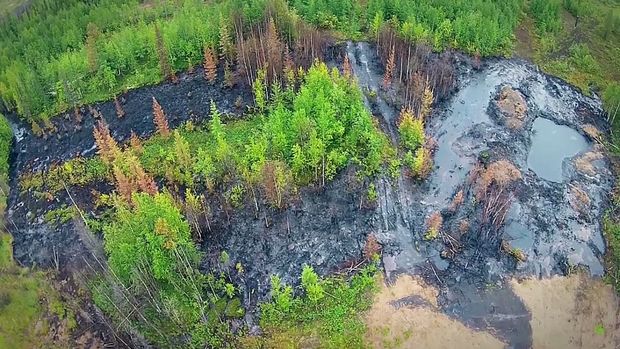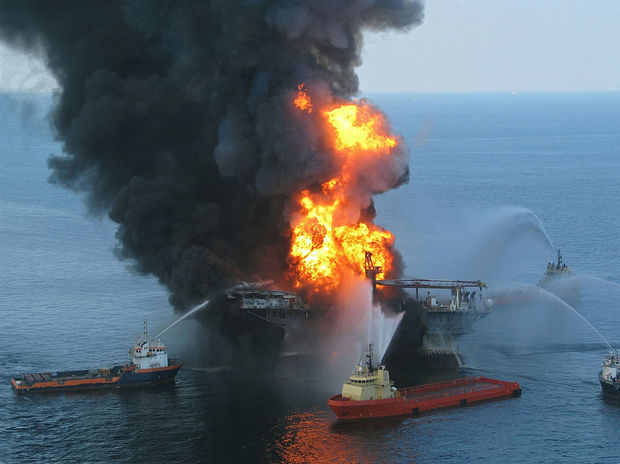Annual oil spills in Russia twice more than detected during 2010 Deepwater Horizon crash
1,5 million tonnes of oil are spilled in Russia every year because of high infrastructure deterioration. Usinsk oil field in the Komi Republic managed by Lukoil is one of the most polluted areas, according to Greenpeace reports; oil pollution here affects not only wild nature but the population's health. Speaking about the entire country, we had over eleven thousand pipeline breaks detected in 2014.
1,5 million tonnes of oil are spilled in Russia annually, The Guardianreports. The main cause is a 60% deterioration of pipeline infrastructure, says Natural Resources and Environment Minister Sergey Donskoy. Because of affordable fines and poor judgement, oil companies prefer to fix existing spills or even do nothing at all instead of investing in infrastructure improvement. Over a half of the state budget is provided by the oil and gas production industry, and Greenpeace reports that high profitability of oil companies in Russia is based on environmental degradation, and the whole situation is contrary to the current law.

Plenty of oil spills can be found in the Komi Republic in the North of Russia. This is where Russian oil production began in 1745, and the modern oil industry started to develop in the Soviet Union in the 1960-1970s. Now the pipeline infrastructure is pretty worn out, and, therefore, exposed to numerous accidents. The biggest oil spill ever happened in 1994, in the city of Usinsk, which is a regional oil hub with the population almost of 40,000 people. It was a spillage of 60,000 to 120,000 tonnes of oil by different estimations, which polluted a large area of the tundra.
Now the Usinsk oil field is managed by Lukoil, and nature protecting activists keep finding out numerous oil spills all over the area. Over 200 sites were detected in 2014 during Greenpeace's 10-day 'oil patrol', and most of them were caused by pipeline breaks. Lukoil-Komi representatives reported about an investigation held by the company, which showed that there were no oil spills on 1/3 of the stated sites, and other 50 pools of oil were liquidated. The company also reported on investing 20 billion rubles in environmental measures and plans to replace 370 km (about 5% of total pipeline length in the region) of old line in 2016. Despite this, the situation is still bad, and satellite imagery shows lots of new spills in the area. They may be relatively small but threatening for river fish stocks and cattle. Some sites also reported as 'reclaimed' still have signs of oil pollution such as rainbow film on the water and black traces on trees. The situation is more complicated than in warmer climates because there is no natural mechanism for breaking down crude oil in subarctic conditions.
Permanent oil pollution spoils not only wild nature but also drinking water, and statistics obtained in 2010 in the hospital of Ust-Usa (a village with the population of 1,300 on the Pechora river) shows rises in different kinds of illnesses such as circulatory, nervous and endocrine system diseases. Residents depend on oil companies because they often provide the only employment opportunity in the area, but people protest the effects of oil-drilling asking oil companies not to leave, but 'drill in a way so that we can live with clean air and water'. More than 16,000 people have signed a Greenpeace petition demanding oil companies be required to replace by 2022 all more than 25 years old oil pipelines.

Komi is not the only place where oil spills are detected, the situation in more remote areas can be even worse. According to the information given to Greenpeace by the State Energy Statistics Bureau, there were 11,709 pipeline breaks in Russia in 2014. For instance, Canada had less than 150 pipeline involved incidents in the same year. 0,5 million tonnes of oil a year are ejected into the Arctic Ocean through northern rivers such as Pechora. The total quantity of spilled oil in Russia is twice greater than released during the Deepwater Horizon accident in the Gulf of Mexico in 2010. The whole system needs to be changed, and the main item is stricter supervision and environmental legislation observance.